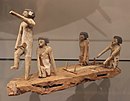Djehutynakht
| Djehutynakht | |
|---|---|
| Nomarch of the 15th nome of Upper Egypt | |
Deir el-Bersha tomb 10A |
Djehutynakht, tentatively identified with Djehutynakht IV or Djehutynakht V, was an
Biography
| |||
| Djehutynakht ḏḥwty-nḫt in hieroglyphs | |||
|---|---|---|---|
| Era: Middle Kingdom (2055–1650 BC) | |||
Once believed to have lived during the reign of
Djehutynakht IV, son of Ahanakht I
If this nomarch was the same of Djehutynakht IV, then he lived at the very end of the 11th Dynasty and was the son of the nomarch Ahanakht I, successor of his brother Ahanakht II, and predecessor of the nomarch Neheri I.
Djehutynakht V, son of Neheri I
If he was the same of Djehutynakht V, then he lived during the late reign of pharaoh Amenemhat I of the 12th Dynasty and was Neheri I's son and successor by his wife Djehutyhotep, and the uncle of his successor Neheri II. In either cases, no children are known for Djehutynakht and his wife.[2] See "Nomarchs of the Hare nome" for a complete genealogy.
Burial
Tomb 10A
Djehutynakht's tomb – designated 10A – was rediscovered in the
The Egyptian government gave the whole content of Tomb 10A to the Museum of Fine Arts. During the naval trip to Boston in 1920, the collection was threatened by a fire on board, but fortunately the damage was very limited. For decades only the “Bersha coffin” and the “Bersha procession” were exhibited at the MFA; in 2009–10 the whole collection was shown in a dedicated exhibition.[3]
Mummy
Mitochondrial DNA analysis
In 2018, the mummified head of Djehutynakht was analyzed for mitochondrial DNA (the DNA from his mother's side) in 2018. Two laboratories independently determined that he belonged to Eurasian mtDNA haplogroup U5b2b5.[6] Similar sequences have been observed in ancient DNA from Phoenicia and Europe but without an exact match and nearest match is a living person from Lebanon and the observed U5 lineage could potentially reflect interactions between Egypt and the Near East that date as far back as the Predynastic and Early Dynastic periods.[6] The sequence is similar to U5a lineage from sample JK2903, a more recent 2000-year-old mummy from Abusir el-Meleq in Egypt.[7] Haplogroup U5 is found in modern Egyptians at moderate frequencies[8][9] but higher in Berbers of the Siwa Oasis in North West Egypt (16.7% in Siwa according to a 2009 study by C. Coudray) [10] The related haplogroup U6 is much more common in most Berber populations.
Gallery
-
“Bersha coffin”.[11]
-
Coffin detail
-
“The Bersha procession”[12]
-
Head of the mummy[4]
-
Model boat
-
Statuette of Lady Djehutynakht[13]
-
Model
References
- ^ "Statuette of Governor Djehutynakht". Boston Museum of Fine Arts. Retrieved September 4, 2015.
- ^ ISBN 90-72690-01-X. pp. 70-2
- ^ a b c "The Secrets of Tomb 10A: Egypt 2000 BC". Boston Museum of Fine Arts. Retrieved September 4, 2015.
- ^ a b "Head of the mummy of Djehutynakht". Boston Museum of Fine Arts. Retrieved September 4, 2015.
- PMID 29494531.
- ^ PMID 29494531.
- PMID 28556824.
- PMID 23910099.
- PMID 19414160.
- S2CID 21826485.
- ^ "Outer coffin of Djehutynakht". Museum of Fine Arts Boston.
- ^ "The Bersha Procession". Boston Museum of Fine Arts. Retrieved September 4, 2015.
- ^ "Statuette of Lady Djehutynakht". Boston Museum of Fine Arts. Retrieved September 4, 2015.

![“Bersha coffin”.[11]](http://upload.wikimedia.org/wikipedia/commons/thumb/e/e4/Outer_Coffin_of_Djehutynakht_5.jpg/130px-Outer_Coffin_of_Djehutynakht_5.jpg)

![“The Bersha procession”[12]](http://upload.wikimedia.org/wikipedia/commons/thumb/2/2b/Bersha_Procession_1.jpg/130px-Bersha_Procession_1.jpg)
![Head of the mummy[4]](http://upload.wikimedia.org/wikipedia/commons/thumb/a/a4/Head_of_the_Mummy_of_Djehutynakht.jpg/130px-Head_of_the_Mummy_of_Djehutynakht.jpg)

![Statuette of Lady Djehutynakht[13]](http://upload.wikimedia.org/wikipedia/commons/thumb/3/37/Tomb_of_Djehutynakht_8.jpg/103px-Tomb_of_Djehutynakht_8.jpg)
